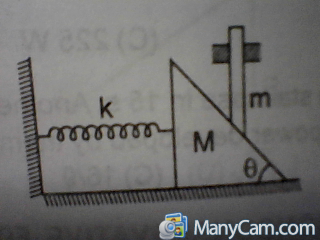Spring Potential Energy Problem

A wedge of mass M fitted with a spring of stiffness 'k' is kept on a smooth horizontal surface. A rod of mass m is kept on the wedge as shown in the figure. System is in equilibrium. Assuming that all surfaces are smooth, the potential energy stored on the spring is:
A) B) C) D)
No vote yet
8 votes
Easy Math Editor
This discussion board is a place to discuss our Daily Challenges and the math and science related to those challenges. Explanations are more than just a solution — they should explain the steps and thinking strategies that you used to obtain the solution. Comments should further the discussion of math and science.
When posting on Brilliant:
*italics*or_italics_**bold**or__bold__paragraph 1
paragraph 2
[example link](https://brilliant.org)> This is a quote# I indented these lines # 4 spaces, and now they show # up as a code block. print "hello world"\(...\)or\[...\]to ensure proper formatting.2 \times 32^{34}a_{i-1}\frac{2}{3}\sqrt{2}\sum_{i=1}^3\sin \theta\boxed{123}Comments
Make free body diagram of forces on both the blocks one by one. For wedge of mass M the forces acting along the floor are N sinθ (normal reaction from block of mass m) and kx. Next, make free body diagram of block of mass m. Forces acting on it perpendicular to the floor are N cosθ and mg. Solving these equations
Nsinθ = kx,
Ncosθ = mg,
We get the value of x, hence value of potential energy can be evaluated.
c
Log in to reply
Solution????
Start with determining the state of spring at equilibrium. Should it be compressed or stretched to keep the system at equilibrium?
My attitude towards the problem is this: The weight, mg, of the rod will have 2 components- mgsin0 and mgcos0. The component, mgcos0, can be again resolved into two vectors having a horizontal component, mgcos0sin0. For equilibrium, the spring force should be equal to horizontal force. Therefore, mgcos0sin0= kx. We can now substitute value of x from this equation in the equation for spring potential energy, i.e., 0.5kx^2.
Log in to reply
I fear your reasoning is not accurate. You are making components of components. This is probably wrong way and you will get the wrong answer I think.
Log in to reply
mgcos0 (0 to be read as theta) is not a component but the normal reaction of m on M... So there are two forces on M....one is the spring force kx which is horizontal and towards right...and the other is the normal reaction of m on M which towards left, and downwards making an angle of (ninty - theta) with the horizontal...So, on resolving mgcos0 in the horizontal left direction, we get mgcos0sin0...and for M to remain in equillibrium, kx should be equal to mgcos0sin0...
so,
mgcos0sin0 = kx
x=(mgcos0sin0)/k
the potential energy stored in spring = 1/2(k . x^2)..
solvong further will give the answer... So the explanation of Shubham S is accurate....
kx=mgtan@
x=mgtan@/2k
1/2 kx^2 = m^2g^2tan^2/2k
BY DIMENSIONAL ANALYSIS IT CAN ONLY BE C OR D MOSTLY C
Log in to reply
Mind keeping Caps Lock off. :P
how can u say it is mostly c)?
make forces acting on M, weight of m & a force F which is acts opposite to spring force to keep system is in equilibrium. then \Tan\theta\ = F\mg. from this find out F and substituted in P.E = F*2\ 2K get the ans... (C) is correct